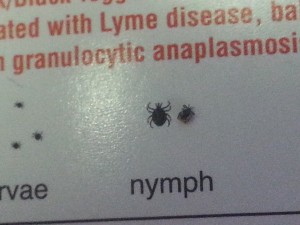Ticks are disgusting, but don’t take my word for it. Aristotle, Cato, and Pliny all referred to ticks as “disgusting parasites”. Unfortunately, they pose a greater risk than making you feel like you have things crawling on you. They are a public health risk because they can transmit several diseases, including Lyme disease.

With this in mind, I always conduct a careful tick check from head to toe after spending time outdoors. After finding two ticks, one adult and one, well, not an adult, I knew it was worth my time. I was eager to get the small one under a microscope to see if I had found a larva, as they are not capable to passing along any diseases. Alas, it was a nymph, meaning that it had already taken a blood meal and was a possible disease carrier. You can understand my confusion, as it is half the size indicated on the New York State Tick ID Card!
Daily tick checks are the best way to protect you and loved ones from ticks and the diseases they carry. The TickEncounter Resource Center has a nifty application that shows which ticks will most likely be found on different parts of your body. The tick species, sex, and age matter! Another handy app is TickClick, a comprehensive, educational application designed to help you identify ticks, have a safe plan of action should you be bitten by a tick, assess disease risk if bitten, and prevent tick bites altogether.
By the way, don’t depend on swimming or showering to remove ticks. They can survive being submerged. Ticks can even survive a trip through the washing machine. (A hot dryer, however, will do them in after 15 minutes. It is best to throw clothes in the dryer prior to washing.)
If you find one embedded in your skin, tweezers are best! Use fine-pointed tweezers to grab the tick as close to the skin as possible and pull straight up until the tick releases. Grab it too high, or using other methods such as matches, nail polish, or petroleum jelly, could irritate it, causing it to regurgitate its disease ridden stomach contents directly into your blood stream. Need a video?
Awareness and a little precaution can help you steer clear of tick-borne illness and the discomfort of being bitten by ticks. See our Understanding and Managing Ticks – A Guide for Schools, Child Care and Camps fact sheet for more information on ticks and how to manage them.